A Man’s Guide to Sweaters
A quality sweater that properly fits is one of the most flattering garments a man can wear. It adds weight to a skinny physique and streamlines a large figure. Functionally it keeps you warm while style wise it can break up the monotonous wearing of dress shirts and slacks to the office. Yet most men know little about sweaters and even fewer take full advantage of all the styles and patterns available. This article will give you a strong understanding of sweater fabrics, fit, and style; the goal being not to change you, but rather expose you to options you might not have considered so you can dress in a manner that best reflects your individuality.
Part 1 – Sweater Fabrics
Sweater Fabric TypesCashmere Sweaters – The gold standard of sweaters, a pure cashmere sweater can cost hundreds of dollars due to the scarcity of the long downy Kashmir goat hair from which it draws its name. Warm and light as a feather, a cashmere sweater is a substantial investment for any man. My advice when purchasing a cashmere sweater is to ensure 1) it fits perfectly 2) you have occasion to wear it at least four times a year 3) it is of a simple, timeless, dark color and 4) you buy it from a reputable merchant (counterfeit sweaters are a poor investment). Cry once about the price, then wear it every chance you get and feel like a million dollars. If you take care of your cashmere sweater you should get 200+ wears out of it over 10 years.
Wool Sweaters – The oldest and most common quality sweater fabric, wool is the traditional favorite when it comes to looks and function. Wool knitted clothing was historically the clothing of common laborers in rural England; today its proven ability to retain heat, fine hand, and history make it a favorite of men all over the world. Wool sweaters do, however, require great care as they are very susceptible to damage from heat and rough handling, especially when wet (wool loses 30% of its strength when soaked).
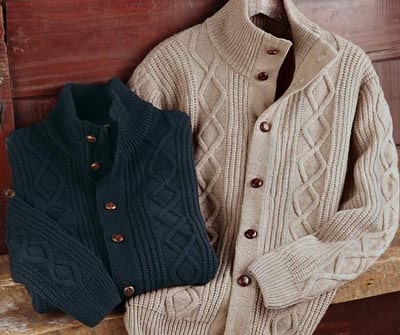
Cotton Sweaters – Sweaters made from cotton fabric (all other factors being equal) are going to be cooler than either their wool or cashmere brethren as their cellulose foundation sheds heat faster. This isn’t a bad thing – sometimes you want a cooler sweater and cotton sweaters can be worn directly on the skin with no irritation. Also, the use of cotton has helped to drive down sweater costs.
Synthetic Fabric Sweaters – In line with cotton, the big advantage of synthetic fabrics is that they have driven down the cost of these garments. Depending on the type of fabric being used, a synthetic fabric sweater can mimic the properties of wool or cotton, oftentimes without the problems of having to take special care of the garment when it comes to washing and handling. Be careful though when purchasing a synthetic fabric sweater – it will in most cases be of a lower quality than its wool/cashmere fiber counterpart.
Blended Fabric Sweaters – Oftentimes you’ll see a sweater made from two or more fabrics; the reason most manufacturers do this is 1) to save money and 2) to increase performance and desired performance properties. This cost savings is often seen with cashmere blends, as a company can call their sweater a “cashmere” sweater when in reality a large part of the sweater is made from less expensive wool or synthetic fibers. Neither bad nor good, this is simply a case where the consumer should learn to read labels and understand that oftentimes you get what you pay for. The second part, increasing performance/desired properties, is why I consider this practice acceptable. Simply put, by mixing in other fibers a sweater manufacturer can create a garment that fits and performs even better than a pure fabric garment.
Sweater Color
Sweater color affects the situations in which a sweater can be worn. Darker colors are typically seen as more formal and conservative, although light colored sweaters are more acceptable in the spring and summer months. Brighter colors, due to the fact they draw attention to the wearer, are less formal but can be great for casual wear and giving the impression of not taking oneself too seriously. Extremely bright colors are best avoided unless you are a performer or highway worker.Sweater Pattern
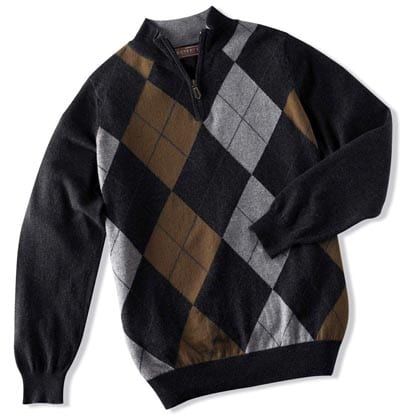
Sweater Weave
Sweater weave affects the heat retaining properties, fit, and level of formality of a sweater. Typically heavy rib patterns will make a sweater thicker, increasing its ability to keep you warm and enabling a former fit. Plain woven sweaters are going to be less elastic, slightly cooler, but the more delicate look gives them a more professional appearance.Part 2 – Sweater Fit
A $500 cashmere sweater will look comical if it’s too small; if it’s too big it will look like a hand-me-down from your big brother. What is the key to finding a good fit? Learn which brands suit you best, and stick with them. Every clothing brand uses different models that they build their clothing off of – you want to find the line that uses a person who most resembles your body’s build. A large sweater made by Calvin Klein is very different than a large found at Wal-Mart – high end designers make their clothing to fit one in ten men (fit less, but for those lucky few a great fit) – larger manufacturers build their clothing lines to fit most men (thus poorly fit all). Custom sweaters are an option for those willing to pay a bit more.Altering sweaters is a mixed bag – less expensive sweaters often have parts that are sewn and can be slightly altered. Occasionally you’ll find a master stitcher who can even rebuild parts of the garment for a reasonable price. Many times though the alterations needed are beyond the skill set of an average seamstress and most skilled tailors will not touch this specialty work. My advice is to make sure the sweater fits at the onset or if you’re adventurous, try this method yourself (minus the flower).
Sweaters can be paired with pants....or a kilt.
Part 3 – Sweater Style
Men’s Turtleneck Sweaters – A dark colored, well-fitted quality turtleneck sweater should be a staple in every man’s wardrobe; paired with dark trousers it will make almost any man look leaner, taller, and more stylish. It can be worn with a suit, with a sports jacket, or simply by itself. Adopted by creative professionals, it nonetheless is at home on a submarine or the streets of San Francisco. All the proof you need to wear a Turtleneck Sweater
All the proof you need to wear a Turtleneck Sweater
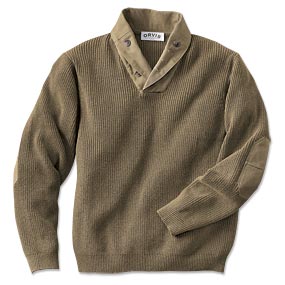 A WWII inspired pull-over makes a handsome choice for casual wear.
A WWII inspired pull-over makes a handsome choice for casual wear.Men’s Cardigan (Zip & Button Down) Sweaters – One of the most versatile and underused sweaters in a man’s wardrobe, they have a stigma of being an “old man’s sweater.” Nothing could be further from the truth – cardigans compliment men of all ages, whether worn over a dress shirt, layered under a sport jacket, or matched with a suit. They are simple to remove and put back on, and are the only sweater type to incorporate a pocket.
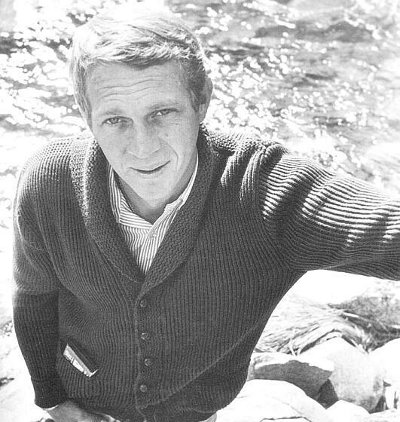
Men’s Aran Sweaters – An Irish original, an authentic Aran sweater is a work of art with a weave that declares the wearer’s clan and history. The story goes that these sweaters originally served the dual purpose of keeping a man warm on the open ocean and enabling identification if he was thrown overboard and drowned. Today, they are still made by hand on the Emerald Isle, with each sweater requiring approximately 100,000 stitches! Aran sweaters are best worn over clothing rather than under a sport jacket.
 Which is Murphy....Which is O'neil?
Which is Murphy....Which is O'neil?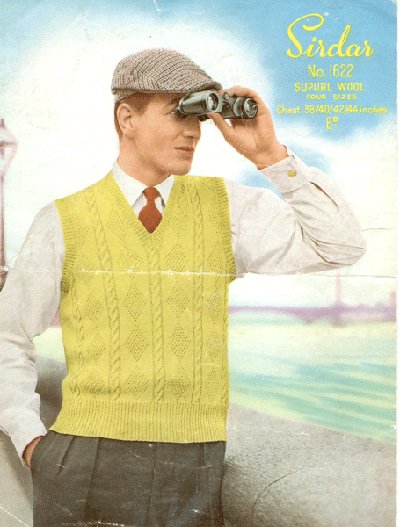
Cold Weather Dressing
And that was the easy part–what I hated was the cold!
You see we did this year round–to include those Iowa winters where the temperature was freezing on the ground and even colder in the air, where winds would create wind chills easily below -20 degrees Fahrenheit.
Climbing those towers covered with ice I learned very quickly how to dress for extreme cold weather. We had clothing needs similar to that of an outdoor athlete, as the climb up and the work was physically taxing and would cause sweating, while at other times we needed extra insulation as we would be sitting still for hours performing delicate tuning work.

In order to add to the lessons I learned in the field on how to stay warm in freezing conditions, I spoke with the cold weather dressing experts at Carol Davis Sportswear and Northern Outfitters. And today I’ll be sharing the advice I gleaned from those conversations with you.
Understanding Layering
The key to cold weather dressing is layering.
Let me repeat that: The key to cold weather dressing is layering.
Layering basically means just what it sounds like: wearing multiple layers of garments, one on top of the next. Several lighter layers will keep you warmer than one very thick one–air is trapped between each layer and warmed by your body, surrounding you with a self-generated heat shield that insulates you from the cold.
Of course, some types of clothing do a better job than others. Layering regular street clothing until it will keep you warm in sub-zero temperatures will leave you so bulky that you might as well roll to wherever you’re going. That’s not our goal.
 If you can't put your arms down, you know your attempt at layering has gone terribly wrong.
If you can't put your arms down, you know your attempt at layering has gone terribly wrong.Experts break layering into three sections:
1) the base layer
2) the insulating layer
3) the outer protection layer
Let’s cover each layer in detail.
1. Base Layer
Your cold weather base layer lies against your skin and is primarily meant to provide the first layer of insulation and most importantly deal with moisture removal. Staying warm and active means occasionally sweating, and sweating is bad if your clothing doesn’t allow it to move out and away from your skin. Water on the skin in cold weather can turn deadly as it can lead to rapid heat loss, so ensure you use an inner layer that pulls sweat away from the body.
 Old
fashioned solutions mostly relied on garments made from loose wool
strings, which absorbed the moisture and had enough thickness for it to
soak toward the outside of the clothing. More modern solutions use
synthetic fibers in much the same way.
Old
fashioned solutions mostly relied on garments made from loose wool
strings, which absorbed the moisture and had enough thickness for it to
soak toward the outside of the clothing. More modern solutions use
synthetic fibers in much the same way.The process of drawing moisture away from the body is often referred to as “wicking.” Athletic and specialty cold weather garments are the best balance between moisture wicking properties and thin, lightweight construction. They add almost no bulk and if properly fitted allow extreme flexibility.
Your hands and feet need layers as well, and liner socks are key to any kind of warm weather outfit. Camping stores sell these quite inexpensively so don’t skip on this purchase; wear them under thicker socks to keep your feet dry. Fingerless liner gloves or very thin wool gloves make a useful base layer for the hands, where sweat is less of a concern but an extra layer still adds warmth by trapping air.
2. Insulating Layer
The job of your main insulating layer is to trap in heat.
Natural fibers like goose down and wool have excellent insulating properties. They provide a lot of heat for reasonably light weight, which is a concern for more active cold weather situations like skiing or hiking. Wool can absorb 30% of its weight and not feel wet and even continues to provide some insulation when soaked, while down loses its effectiveness when wet (but is lighter overall and has better insulating properties that wool).
Wool (to include cashmere and angora) sweaters are some of the dressiest options available that still provide serious winter warmth. A good wool sweater paired with a regular cotton dress shirt makes for a functional insulating layer for around the town needs on seriously cold days.
“Performance fleece”–actually a trademarked term, but widely used these days to describe any artificial fleece garment–is lightweight and a proven insulator. Its best property is that it continues to insulate when wet, but it offers little protection from the wind unless layered with a tightly woven, wind resistant fabric. These are often among the least expensive and most widely available options for insulating layers.
Thick wool or fleece trousers make the best insulating layer for your legs. Over a base layer they’re extremely warm. Jeans can serve as light protective wear, but they offer little if any insulating properties. Men that live and work in cold weather areas stay away from jeans unless they’ve been lined with an inner insulating layer.
3. Protective Layer
Your outer layer is the shell that keeps all the inner layers protected from the elements. It’s usually (though not always) a single layer, and doesn’t necessarily have to have any insulation.
The most important consideration for your protective layer is that it traps air and stops wind. It should also be breathable enough to allow moisture out–you don’t want your sweat trapped under your shell with you. That means that most outer layers are water-resistant but not fully water-proofed.
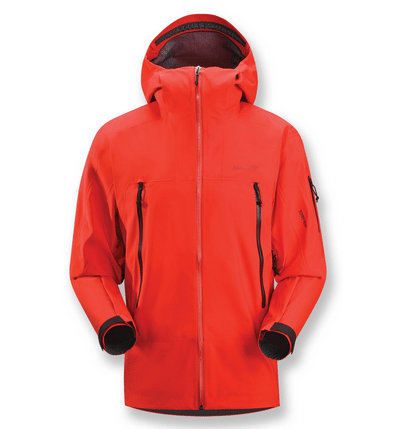
Most serious cold-weather shells are designed as outdoor gear. They don’t tend to have a lot of fashionable styling. If you’re primarily interested in dress or business clothing that can provide warmth as well, there are treated wool overcoats that have a windproofed layer or treatment with GOR-TEX and similar materials. Alternatively, buy your parka or shell in the plainest, darkest design you can find and don’t worry about it too much–once the temperature drops below zero people start making allowances for more functional-looking styles.
The outer layer also includes protection for your extremities. A layer of weather-proofed gloves or mittens and a wool stocking cap are the bare minimum of protection. An insulated headband, a scarf, and good winter boots also help. Waterproof hiking boots work up to a point, but in really cold weather the best winter boots are soft-sided, natural fiber-lined pieces with built-in insulation and thick, flexible soles.
I would like to note many cultures still make use of “skins” as natural outer protective layers. Any American visiting Ukraine during the winter will notice 1) that no one de-ices the sidewalks and 2) that everyone seems to own a large fur coat and ushanka.
Your Unique Situational Needs
Not all cold weather gear serves the same function. Someone who’s going dog sledding for a week needs a very different set-up from someone who wants to keep walking to work once the temperature drops below zero.Cold Weather Active — Running, Cross-Country Skiing, Etc.

Winter sports enthusiasts need gear that’s lightweight as well as insulating and weatherproof. Dedicated joggers may even wind up skipping the outer shell layer entirely since their body temperature will stay high, they’ll be out for a limited amount of time, and breathability is key to comfort. Obviously, this only works for men who can step outside, do their activity, and step immediately back into a warm shelter. Anyone without that luxury will need the outer layer.
High-performance outdoor gear makes the best active cold weather gear. Synthetic fibers can provide much lighter-weight comfort than heavy wool and down. Two to three thin layers of warm jackets and leggings are ideal, topped off with an insulated headband and some weather-proofed gloves.
An outer/shell layer with its own insulation may be ideal for cold weather active situations since it can be worn during idle time, set-up of equipment, walking or other transportation, etc., and then removed when the intense activity starts.
Cold Weather Non-Active — Snowmobiling, Hunting, Etc.

Men who are going to be sitting still for long periods need gear that’s more focused on trapping warmth and less on letting moisture and air breathe out.
Serious cold weather gear for people who are out all day (and not exercising hard) relies on thick insulating layers and a weatherproofed shell. If water isn’t a concern, a down layer paired with thinner wool layers and an artificial-fiber shell is perfect.
More layers are also needed, including on the feet and hands. A couple different thicknesses of socks, with a moisture-wicking liner sock, and a thick, insulated boot keeps the feet warm. Thin gloves should go under a thicker pair, which can in turn go into an insulated (and cuffed) pair of mittens that stay on until manual dexterity is needed.
Cold Weather Business Dress
Most office jobs don’t require a man to spend too much time outside in the winter. But if you happen to need to look a little sharp and it’s twenty below, what do you do?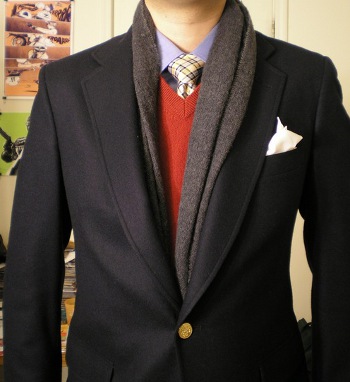
Image from The Silentist
Layering, as usual, is key. Wear your usual dress shirt and tie over
a long-sleeved, moisture-wicking underlayer — cotton traps moisture
well enough that you don’t want it against your body. A thin sweater on
top of that (cashmere gives excellent warmth while remaining
lightweight and compact) can go under a heavy worsted wool jacket. Wool
trousers can be matched as a suit or odd trousers, and should go over
good, thick long johns.Wear the longest and heaviest wool overcoat you can find on top of it all, and if things get extreme, consider getting it treated with a DWR (durable water repellant), GOR-TEX, or similar coating. Thin dress socks in wool/synthetic blends are available at most camping stores these days, in conservative colors, and can be worn over a liner sock with your dress shoes. An insulated headband under a dress hat of the same color is usually presentable, or just wear a plain, dark stocking cap.
The Importance of Fit
Fit is important in winter wear as your layering clothes still have to allow freedom of movement–one poor fitting garment can restrict your ability to ski or work freely.Your base layer should always be as closely fitted as possible. It’s there to absorb moisture from your skin, and it needs to be touching your body to do that effectively. Most good Under Armor-style garments have elastic or other stretchable material in them to allow a skintight fit.
Insulating layers should be stacked from the thinnest and tightest to the thickest and loosest. A light wool sweater doesn’t provide effective insulation if it’s stretched out over a puffy down vest. Wear multiple layers when you go to buy heavy winter jackets and other insulating garments to make sure they fit over all the layers you’ll be wearing in serious cold weather situations.
Shells should have a little looseness between them and the insulating layers. This helps with airflow and also with wetness–a water-resistant (but not fully waterproofed) surface is most likely to leak through when it presses against the clothes beneath it.
Cold Weather Gear – Piece by Piece
Hats: Insulated headbands for active exercise and warmer/sunnier days. Stocking caps for colder weather and stationary or light exercise. Balaclavas/ski masks for the coldest and windiest days–bring a couple, since they get wet and lose their effectiveness over time from your breath.Goggles: Important protection from wind, which can make eyes tear up and lashes freeze. Dark lenses may also be needed if there’s lots of snow and sun.
Scarves: Vital wind protection. Always have one tucked under the shell layer.
Parkas: Big, insulated outer layers that reach down to the knees or lower. The most intense of outer layers. Bulky but very effective. Almost always include a hood for extra warmth.
Ski Jackets: Waist-length insulated jackets with a waterproofed or water-resistant exterior. Thinner and lighter than parkas, making them a little more versatile.
Weatherproof Shells: Soft garments made of treated fabric that stop wind and water but have little or no insulation of their own. Useful lightweight protection to pair with thick insulation layers.
Sweaters: A standard insulation layer. Wool is the best–thick, natural wool with the lanolin still in it is extremely durable and water-resistant, while lighter cashmere wool makes very lightweight garments that still provide good insulation.
Performance Fleece: Excellent for cold weather exercise. Very breathable, but not windproof at all, and tends to be bulky.
Snow Pants: Big, insulated pants (usually overall-style) with a waterproof or water resistant outer layer. Bulky but extremely warm. Made to fit over regular trousers.
Wool Trousers: Useful as both dress clothes and cold weather gear. Thicker wools add more warmth and can handle more wetness.
Flannel-lined Pants: Common in blue jeans and other work clothes. Adds a layer of insulation to regular, functional pants. Basically worthless when wet, however.
Snow Boots: Soft-sided boots with flexible soles and insulation on the insides. Usually waterproof.
Wool Socks: Vital layer for the feet. Can come quite thin in wool/synthetic blends, but the extra padding of thick wool socks helps trap more air for warmth.
Liner Socks: Synthetic socks meant to be worn under warmer socks. Useful for wicking moisture away from the feet.
Long Underwear: Wool or synthetic (or a blend of both). Makes a huge difference in keeping the legs warm.
Under Armor (and similiar type garments): Athletic-style moisture-wicking undershirts. Vastly preferable to plain cotton undershirts, which trap moisture and stay clammy.
Wool Gloves: Thin sock-style gloves used as an extra layer below thick gloves or mittens.
Ski Gloves: Or basic winter gloves; fingered gloves with padded insulation and weatherproof exteriors.
Mittens: Big, fingerless gloves. Can be made from insulation and a synthetic liner similar to ski gloves, or from natural sheepskin with the wool still attached and the leather side out.
Cold Weather Dressing In Conclusion
Alright – you’ve read my lessons on cold weather dressing. What tips do you have to offer? I know there are a lot of readers in Canada, Alaska, and even Northern Europe. What did I miss? Let’s hear it in the comments!Written by
Antonio Centeno
No comments:
Post a Comment